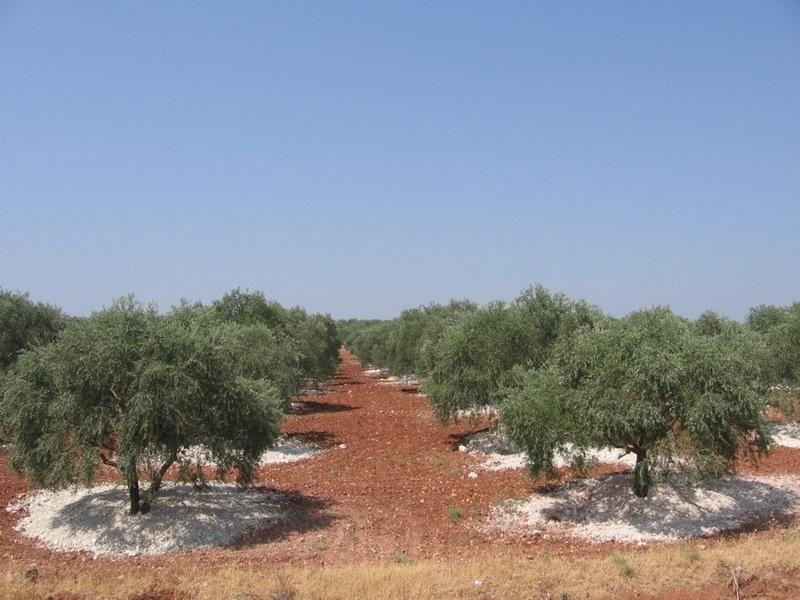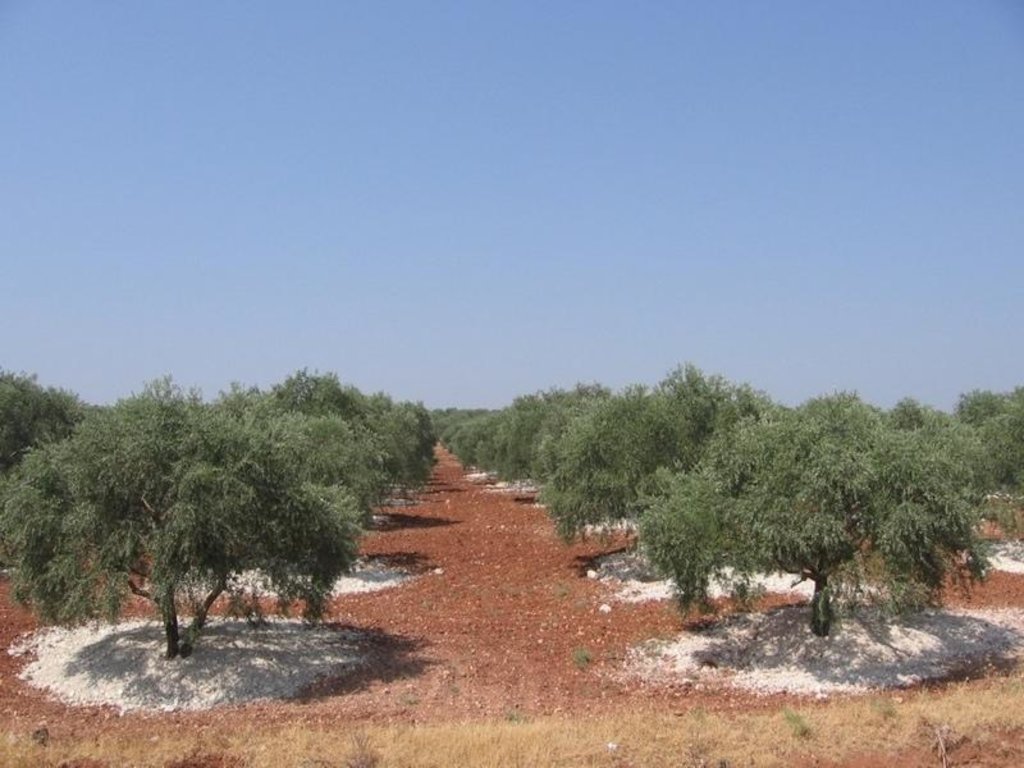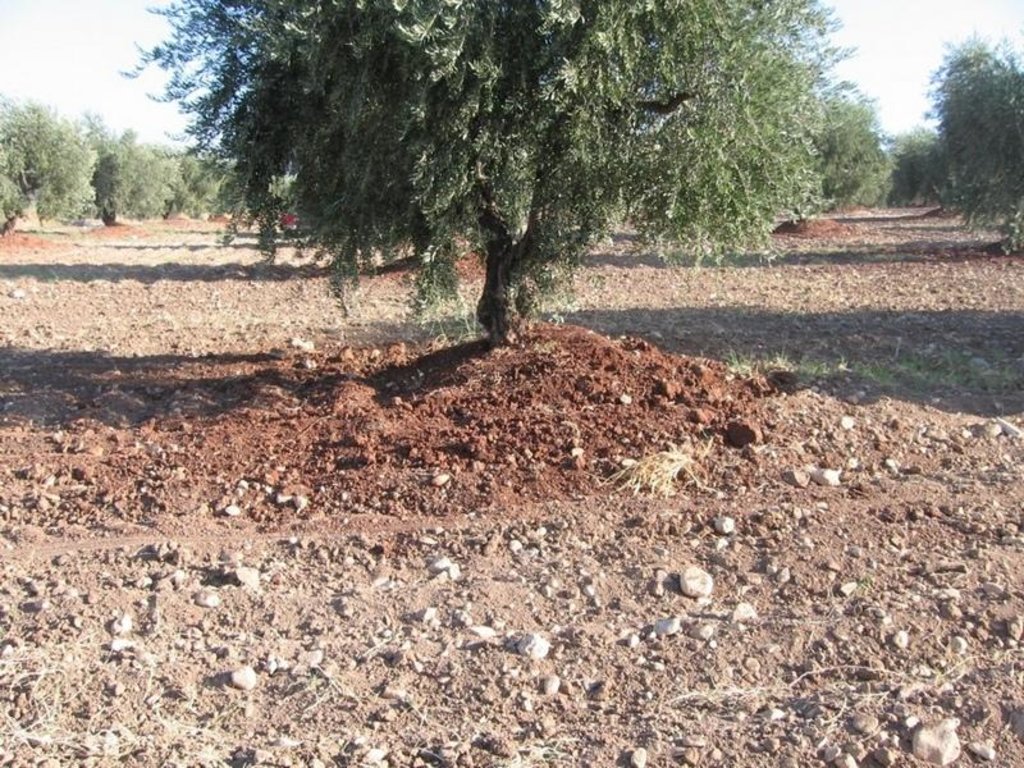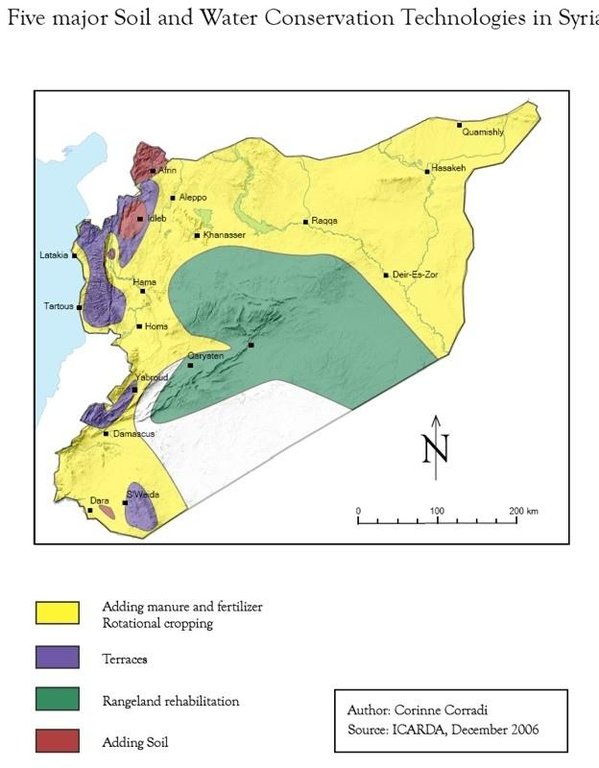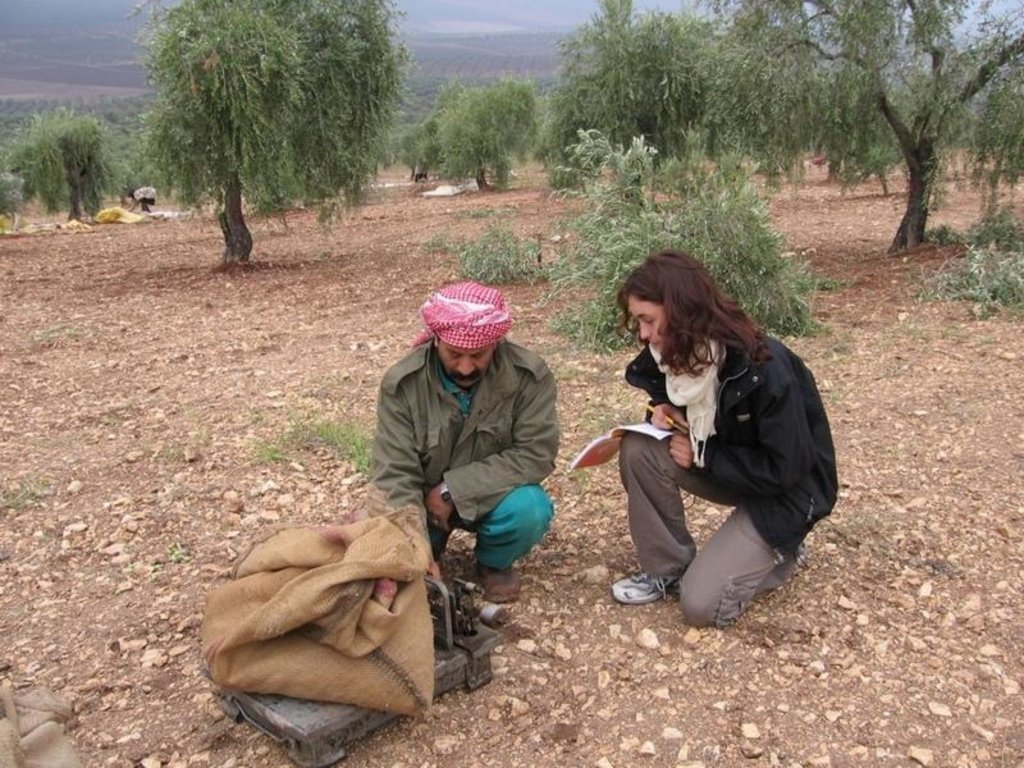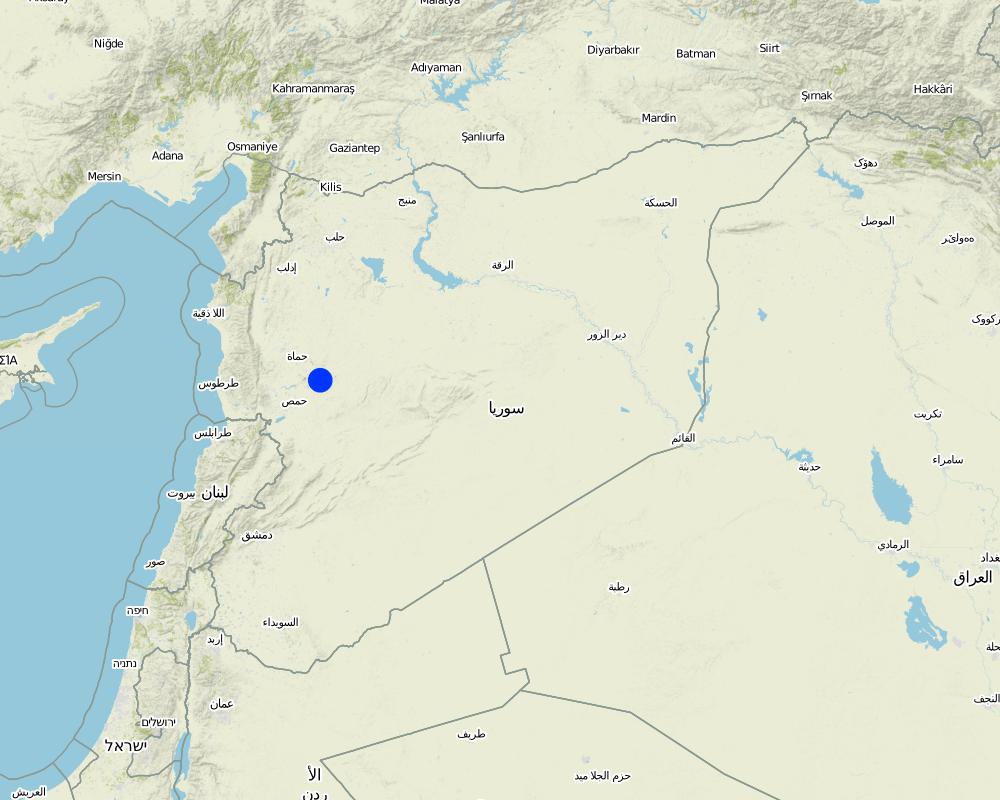Adding Soil [Syrian Arab Republic]
- Creation:
- Update:
- Compiler: Liesbeth Colen
- Editor: –
- Reviewers: Fabian Ottiger, Alexandra Gavilano
Taghir al Turbe (arabic), akhelete (kurdish)
technologies_1004 - Syrian Arab Republic
View sections
Expand all Collapse all1. General information
1.2 Contact details of resource persons and institutions involved in the assessment and documentation of the Technology
SLM specialist:
1.3 Conditions regarding the use of data documented through WOCAT
The compiler and key resource person(s) accept the conditions regarding the use of data documented through WOCAT:
Ja
1.5 Reference to Questionnaire(s) on SLM Approaches (documented using WOCAT)
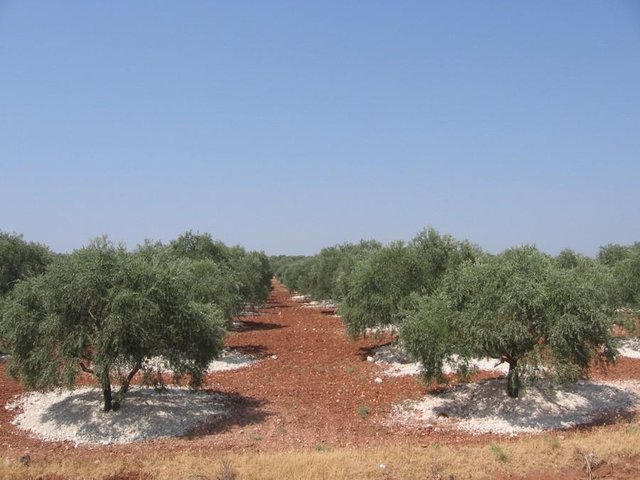
Adding soil [Syrian Arab Republic]
No description available.
- Compiler: Liesbeth Colen
2. Description of the SLM Technology
2.1 Short description of the Technology
Definition of the Technology:
To add red (fertile, nutrient rich) valley soil to degraded white soil on slopes (in olive orchards)
2.2 Detailed description of the Technology
Description:
Red soil is taken from valley fields, mines and construction work, transported to the slopes and added around the stem of each tree, ca. 2 m^3 per tree. Not done in the rainy season and only when there is soil available and spare time.
Purpose of the Technology: increase the soil depth and add nutrients in response to erosion and nutrient mining.
Establishment / maintenance activities and inputs: every five to ten years depending on rainfall and slope.
2.3 Photos of the Technology
2.5 Country/ region/ locations where the Technology has been applied and which are covered by this assessment
Country:
Syrian Arab Republic
Region/ State/ Province:
Aleppo
Further specification of location:
Idleb, Affrin
Comments:
Comments:
Total area covered by the SLM Technology is 0.04 km2.
Idleb no information available, probably 1.5 times more than Affrin
Map
×2.6 Date of implementation
If precise year is not known, indicate approximate date:
- less than 10 years ago (recently)
2.7 Introduction of the Technology
Specify how the Technology was introduced:
- through land users' innovation
Comments (type of project, etc.):
Idleb (region around Harem), 70 km from Aleppo, West
3. Classification of the SLM Technology
3.1 Main purpose(s) of the Technology
- improve production
- reduce, prevent, restore land degradation
- create beneficial economic impact
3.2 Current land use type(s) where the Technology is applied

Cropland
- Annual cropping
- Tree and shrub cropping
Tree and shrub cropping - Specify crops:
- olive
Number of growing seasons per year:
- 1
Comments:
Major land use problems (compiler’s opinion): Water erosion on hill slopes, poor soil quality (vulnerable to erosion and lack of nutrients), exageratet tillage in olive orchards
Major land use problems (land users’ perception): loss of top soil due to water erosion, poor soil quality, difficult to do contour tillage because of steep slopes
3.4 Water supply
Water supply for the land on which the Technology is applied:
- rainfed
Comments:
Water supply: Also mixed rainfed - irrigated
3.5 SLM group to which the Technology belongs
- integrated soil fertility management
3.6 SLM measures comprising the Technology
3.7 Main types of land degradation addressed by the Technology

soil erosion by water
- Wt: loss of topsoil/ surface erosion
- Wg: gully erosion/ gullying
- Wm: mass movements/ landslides

chemical soil deterioration
- Cn: fertility decline and reduced organic matter content (not caused by erosion)
Comments:
Main type of degradation addressed: Wt: loss of topsoil / surface erosion, Wg: gully erosion / gullying
Secondary types of degradation addressed: Wm: mass movements / landslides, Cn: fertility decline and reduced organic matter content
3.8 Prevention, reduction, or restoration of land degradation
Specify the goal of the Technology with regard to land degradation:
- reduce land degradation
- restore/ rehabilitate severely degraded land
Comments:
Main goals: rehabilitation / reclamation of denuded land
Secondary goals: mitigation / reduction of land degradation
4. Technical specifications, implementation activities, inputs, and costs
4.1 Technical drawing of the Technology
Technical specifications (related to technical drawing):
Technical knowledge required for field staff / advisors: low
Technical knowledge required for land users: low
Main technical functions: increase in soil fertility, adding new soil
Secondary technical functions: sediment harvesting
Mulching
Material/ species: red soil
Remarks: depends on point of view, protection for "old"soil from the newly added soil
Mineral (inorganic) fertilizers
Material/ species: red soil
Quantity/ density: 2m^3/tree
Remarks: new soil mixed with the old one increases nutrient
Structural measure: add
Spacing between structures (m): 6 -10
Height of bunds/banks/others (m): 2
Width of bunds/banks/others (m): 3
Length of bunds/banks/others (m): 3
Construction material (earth): red soil
Slope (which determines the spacing indicated above): 0 - 25%
4.2 General information regarding the calculation of inputs and costs
other/ national currency (specify):
syrian pounds
If relevant, indicate exchange rate from USD to local currency (e.g. 1 USD = 79.9 Brazilian Real): 1 USD =:
50.0
Indicate average wage cost of hired labour per day:
5.00
4.3 Establishment activities
| Activity | Timing (season) | |
|---|---|---|
| 1. | digging soil | dry season |
| 2. | transport soil | dry season |
| 3. | distributing soil |
4.4 Costs and inputs needed for establishment
| Specify input | Unit | Quantity | Costs per Unit | Total costs per input | % of costs borne by land users | |
|---|---|---|---|---|---|---|
| Labour | Labour | ha | 1.0 | 50.0 | 50.0 | 100.0 |
| Equipment | Machine use | ha | 1.0 | 50.0 | 50.0 | 100.0 |
| Construction material | Earth | ha | 1.0 | 100.0 | 100.0 | 100.0 |
| Other | Transport | ha | 1.0 | 100.0 | 100.0 | |
| Total costs for establishment of the Technology | 300.0 | |||||
| Total costs for establishment of the Technology in USD | 6.0 | |||||
Comments:
Duration of establishment phase: 12 month(s)
4.5 Maintenance/ recurrent activities
| Activity | Timing/ frequency | |
|---|---|---|
| 1. | digging soil | dry season / once |
| 2. | transport soil | dry season / once |
| 3. | distributing soil | once |
4.6 Costs and inputs needed for maintenance/ recurrent activities (per year)
Comments:
Machinery/ tools: trolley for transport, machine for digging
for one farmer
4.7 Most important factors affecting the costs
Describe the most determinate factors affecting the costs:
labour, distance, transport, probably in the future also value of soil
5. Natural and human environment
5.1 Climate
Annual rainfall
- < 250 mm
- 251-500 mm
- 501-750 mm
- 751-1,000 mm
- 1,001-1,500 mm
- 1,501-2,000 mm
- 2,001-3,000 mm
- 3,001-4,000 mm
- > 4,000 mm
Agro-climatic zone
- semi-arid
5.2 Topography
Slopes on average:
- flat (0-2%)
- gentle (3-5%)
- moderate (6-10%)
- rolling (11-15%)
- hilly (16-30%)
- steep (31-60%)
- very steep (>60%)
Landforms:
- plateau/plains
- ridges
- mountain slopes
- hill slopes
- footslopes
- valley floors
Altitudinal zone:
- 0-100 m a.s.l.
- 101-500 m a.s.l.
- 501-1,000 m a.s.l.
- 1,001-1,500 m a.s.l.
- 1,501-2,000 m a.s.l.
- 2,001-2,500 m a.s.l.
- 2,501-3,000 m a.s.l.
- 3,001-4,000 m a.s.l.
- > 4,000 m a.s.l.
5.3 Soils
Soil depth on average:
- very shallow (0-20 cm)
- shallow (21-50 cm)
- moderately deep (51-80 cm)
- deep (81-120 cm)
- very deep (> 120 cm)
Soil texture (topsoil):
- medium (loamy, silty)
- fine/ heavy (clay)
Topsoil organic matter:
- low (<1%)
If available, attach full soil description or specify the available information, e.g. soil type, soil PH/ acidity, Cation Exchange Capacity, nitrogen, salinity etc.
Soil fertility: Very low (ranked 1) and low (ranked 2)
Soil drainage/infiltration: Good
Soil water storage capacity: High
5.6 Characteristics of land users applying the Technology
Market orientation of production system:
- commercial/ market
Off-farm income:
- 10-50% of all income
Relative level of wealth:
- average
- rich
Level of mechanization:
- manual work
- mechanized/ motorized
Indicate other relevant characteristics of the land users:
Population density: 10-50 persons/km2
Annual population growth: 2% - 3%
25% of the land users are rich.
50% of the land users are average wealthy.
25% of the land users are poor.
Level of mechanization: Mechanised (ranked 1, tillage) and manual work (ranked 2, harvesting)
Market orientation of production system: export (seasonal)
5.7 Average area of land used by land users applying the Technology
- < 0.5 ha
- 0.5-1 ha
- 1-2 ha
- 2-5 ha
- 5-15 ha
- 15-50 ha
- 50-100 ha
- 100-500 ha
- 500-1,000 ha
- 1,000-10,000 ha
- > 10,000 ha
5.8 Land ownership, land use rights, and water use rights
Land ownership:
- individual, titled
Land use rights:
- individual
6. Impacts and concluding statements
6.1 On-site impacts the Technology has shown
Socio-economic impacts
Production
crop production
Comments/ specify:
20-50% (red on white:63%, white on red: 38%)
risk of production failure
Comments/ specify:
Young roots are encouraged to grow in the new added pile, but there they are more susceptible for damage (ploughin/frost/heat/diseases)
production area
Comments/ specify:
In case soil is taken from good valley fields
Income and costs
economic disparities
Socio-cultural impacts
community institutions
national institutions
SLM/ land degradation knowledge
Ecological impacts
Soil
soil moisture
Comments/ specify:
For white on red soil, increased sand content may result in better infiltration and reduces cracks of topsoil, increased moisture in subsoil reported by farmers
nutrient cycling/ recharge
Comments/ specify:
Adding white soil adds high active CaCO3, which might decrease availabilty of cation nutrients
Biodiversity: vegetation, animals
pest/ disease control
Comments/ specify:
Spreading of soil-borne diseases. Especially Vertcillium Wilt, also Verticillium Dahliae
Other ecological impacts
Topsoil temperature
Comments/ specify:
Adding white soil on red soil might reduce the temerature (less absorption of sunlight) and therefore the evaporation and also repell insects, but this has not been measured
6.2 Off-site impacts the Technology has shown
reliable and stable stream flows in dry season
downstream flooding
downstream siltation
Comments/ specify:
Downfields will benefit if erosion is not stopped
groundwater/ river pollution
wind transported sediments
6.4 Cost-benefit analysis
How do the benefits compare with the establishment costs (from land users’ perspective)?
Short-term returns:
slightly negative
Long-term returns:
positive
How do the benefits compare with the maintenance/ recurrent costs (from land users' perspective)?
Short-term returns:
very positive
Long-term returns:
very positive
6.5 Adoption of the Technology
Of all those who have adopted the Technology, how many did so spontaneously, i.e. without receiving any material incentives/ payments?
- 91-100%
Comments:
100% of land user families have adopted the Technology without any external material support
Comments on spontaneous adoption: estimates
There is a strong trend towards spontaneous adoption of the Technology
Comments on adoption trend: exponential adaption, probably related to the recent (from 2003/2005) increase for olive oil prices and increased construction work
6.7 Strengths/ advantages/ opportunities of the Technology
| Strengths/ advantages/ opportunities in the land user’s view |
|---|
| fast increase in yield |
| reverse the effects of erosion |
| Strengths/ advantages/ opportunities in the compiler’s or other key resource person’s view |
|---|
|
reverse the effects of erosion How can they be sustained / enhanced? combine with other conservation technologies (stone bands etc.) |
|
soil that otherwise wouldn't be used can be used in this way How can they be sustained / enhanced? offer free transport of soil by government or other organisation |
| don't have to apply to the entire field, possibility to keep investment down |
6.8 Weaknesses/ disadvantages/ risks of the Technology and ways of overcoming them
| Weaknesses/ disadvantages/ risks in the land user’s view | How can they be overcome? |
|---|---|
| expensive for the entire field | not |
| Weaknesses/ disadvantages/ risks in the compiler’s or other key resource person’s view | How can they be overcome? |
|---|---|
| it is not sustainable | combine with conservation strategies like terraces, bands, less tillage |
| soil born disease spreading | soil analysis before adding and if positive either apply quarantine and solarization or leave it |
7. References and links
7.1 Methods/ sources of information
7.2 References to available publications
Title, author, year, ISBN:
Soil transfers in olive orchards of NS Syria, a bio-physical and socio-economic analysis of a local innovation. June 2007.
Available from where? Costs?
ICD Bern
Links and modules
Expand all Collapse allLinks

Adding soil [Syrian Arab Republic]
No description available.
- Compiler: Liesbeth Colen
Modules
No modules


